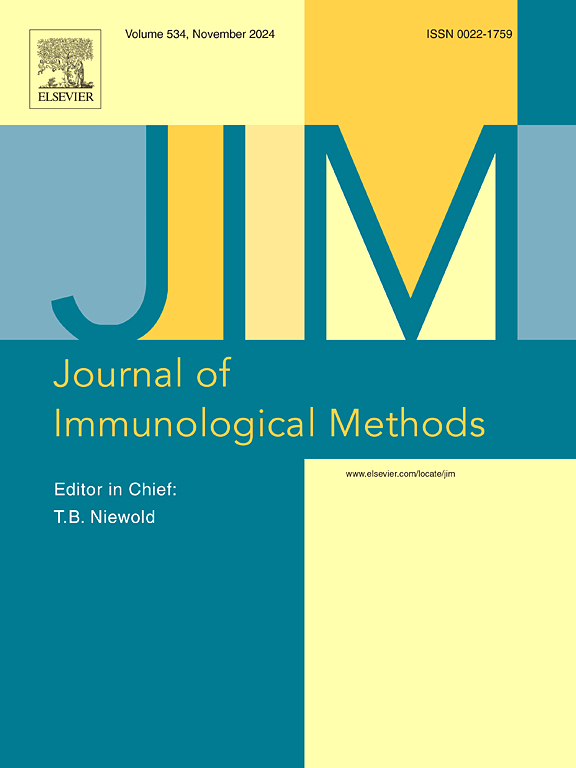使用生物层干涉免疫吸附测定(BLI-ISA)作为间接ELISA替代疫苗开发的高通量多物种平台。
IF 1.6
4区 医学
Q4 BIOCHEMICAL RESEARCH METHODS
引用次数: 0
摘要
在疫苗开发中,ELISA(酶联免疫吸附试验)通常用于比较来自几个治疗组的样品的抗体滴度。这通常需要大量的样品制备、手工劳动以及长时间的孵育和处理时间。生物层干涉法(BLI)已成为ELISA检测和定量生物样品中抗原特异性抗体的替代方法。然而,在疫苗开发中实施BLI作为ELISA的替代品,需要建立准确和可重复结果的实验参数。在这里,我们给出了一种生物层干涉免疫吸附测定(BLI-ISA)的一般方案,用于比较治疗组血清中抗原特异性抗体水平,使用二抗结合反应代替ELISA终点滴度。BLI-ISA提供抗原特异性抗体水平的快速相对测量(以nm结合位移为单位),产生与ELISA终点滴度(以ELISA单位表示)一致的结果,从而在传统ELISA所需的一小部分时间内实现跨治疗组的可靠比较。本文章由计算机程序翻译,如有差异,请以英文原文为准。
A high-throughput multi-species platform using Biolayer Interferometry Immunosorbent Assay (BLI-ISA) as an alternative to indirect ELISA for vaccine development
In vaccine development, the ELISA (Enzyme-Linked Immunosorbent Assay) is commonly used to compare the antibody titers of samples from several treatment groups. This often requires extensive sample preparation, manual labor, and long incubation and processing times. Biolayer Interferometry (BLI) has emerged as an alternative to the ELISA for the detection and quantification of antigen-specific antibodies in biological samples. However, the implementation of BLI as a replacement for the ELISA in vaccine development requires that experimental parameters are established for accurate and reproducible results. Here we give a general protocol for a biolayer interferometry immunosorbent assay (BLI-ISA) for the comparison of antigen-specific antibody levels in treatment group sera that uses secondary antibody binding responses as replacement for ELISA endpoint titers. BLI-ISA provides rapid relative measurements of antigen-specific antibody levels (in nm binding shift), yielding results consistent with ELISA endpoint titers (expressed in ELISA Units), thereby enabling reliable comparison across treatment groups within a fraction of the time required for conventional ELISA.
求助全文
通过发布文献求助,成功后即可免费获取论文全文。
去求助
来源期刊
CiteScore
4.10
自引率
0.00%
发文量
120
审稿时长
3 months
期刊介绍:
The Journal of Immunological Methods is devoted to covering techniques for: (1) Quantitating and detecting antibodies and/or antigens. (2) Purifying immunoglobulins, lymphokines and other molecules of the immune system. (3) Isolating antigens and other substances important in immunological processes. (4) Labelling antigens and antibodies. (5) Localizing antigens and/or antibodies in tissues and cells. (6) Detecting, and fractionating immunocompetent cells. (7) Assaying for cellular immunity. (8) Documenting cell-cell interactions. (9) Initiating immunity and unresponsiveness. (10) Transplanting tissues. (11) Studying items closely related to immunity such as complement, reticuloendothelial system and others. (12) Molecular techniques for studying immune cells and their receptors. (13) Imaging of the immune system. (14) Methods for production or their fragments in eukaryotic and prokaryotic cells.
In addition the journal will publish articles on novel methods for analysing the organization, structure and expression of genes for immunologically important molecules such as immunoglobulins, T cell receptors and accessory molecules involved in antigen recognition, processing and presentation. Submitted full length manuscripts should describe new methods of broad applicability to immunology and not simply the application of an established method to a particular substance - although papers describing such applications may be considered for publication as a short Technical Note. Review articles will also be published by the Journal of Immunological Methods. In general these manuscripts are by solicitation however anyone interested in submitting a review can contact the Reviews Editor and provide an outline of the proposed review.

 求助内容:
求助内容: 应助结果提醒方式:
应助结果提醒方式:


